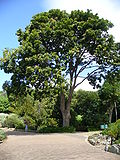Mahogany
Mahogany is a type of hardwood that originates from the Swietenia genus of trees, which is part of the Meliaceae family. This wood is known for its straight-grain, reddish-brown color, and ability to resist decay. Mahogany is used in the production of various items such as furniture, boats, musical instruments, and more.
Characteristics
Mahogany is a dense, strong, and durable wood. It has a straight, fine, and even grain, and is free of voids and pockets. Its reddish-brown color darkens over time, and displays a reddish sheen when polished. It has excellent workability, and is very durable. These characteristics make it a favorable wood for crafting cabinets and furniture.
Species
The three species of the Swietenia genus that yield the genuine mahogany timber are:
- Swietenia mahagoni, found in the Caribbean, Florida, and the Bahamas.
- Swietenia macrophylla, found in Central America and South America.
- Swietenia humilis, a small and often twisted mahogany tree limited to seasonally dry forests in Pacific Central America that is of limited commercial utility.
Uses
Mahogany is used in the manufacture of furniture, high-quality cabinetry, veneer, musical instruments, boat building, and other items that require a strong, stable wood. Due to its durability, it is also used for making flooring.
Conservation status
The Swietenia macrophylla, or big-leaf mahogany, is listed on the IUCN Red List as a vulnerable species. Over-harvesting of this species over the past centuries has led to its current status.
See also
References
Transform your life with W8MD's budget GLP-1 injections from $125.
W8MD offers a medical weight loss program to lose weight in Philadelphia. Our physician-supervised medical weight loss provides:
- Most insurances accepted or discounted self-pay rates. We will obtain insurance prior authorizations if needed.
- Generic GLP1 weight loss injections from $125 for the starting dose.
- Also offer prescription weight loss medications including Phentermine, Qsymia, Diethylpropion, Contrave etc.
NYC weight loss doctor appointments
Start your NYC weight loss journey today at our NYC medical weight loss and Philadelphia medical weight loss clinics.
- Call 718-946-5500 to lose weight in NYC or for medical weight loss in Philadelphia 215-676-2334.
- Tags:NYC medical weight loss, Philadelphia lose weight Zepbound NYC, Budget GLP1 weight loss injections, Wegovy Philadelphia, Wegovy NYC, Philadelphia medical weight loss, Brookly weight loss and Wegovy NYC
|
WikiMD's Wellness Encyclopedia |
| Let Food Be Thy Medicine Medicine Thy Food - Hippocrates |
Medical Disclaimer: WikiMD is not a substitute for professional medical advice. The information on WikiMD is provided as an information resource only, may be incorrect, outdated or misleading, and is not to be used or relied on for any diagnostic or treatment purposes. Please consult your health care provider before making any healthcare decisions or for guidance about a specific medical condition. WikiMD expressly disclaims responsibility, and shall have no liability, for any damages, loss, injury, or liability whatsoever suffered as a result of your reliance on the information contained in this site. By visiting this site you agree to the foregoing terms and conditions, which may from time to time be changed or supplemented by WikiMD. If you do not agree to the foregoing terms and conditions, you should not enter or use this site. See full disclaimer.
Credits:Most images are courtesy of Wikimedia commons, and templates, categories Wikipedia, licensed under CC BY SA or similar.
Contributors: Prab R. Tumpati, MD












